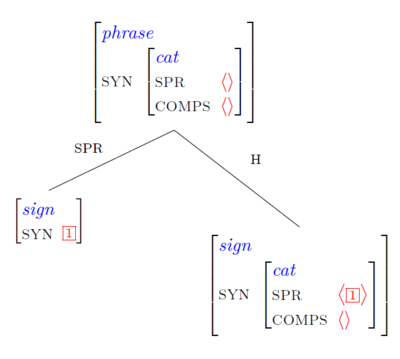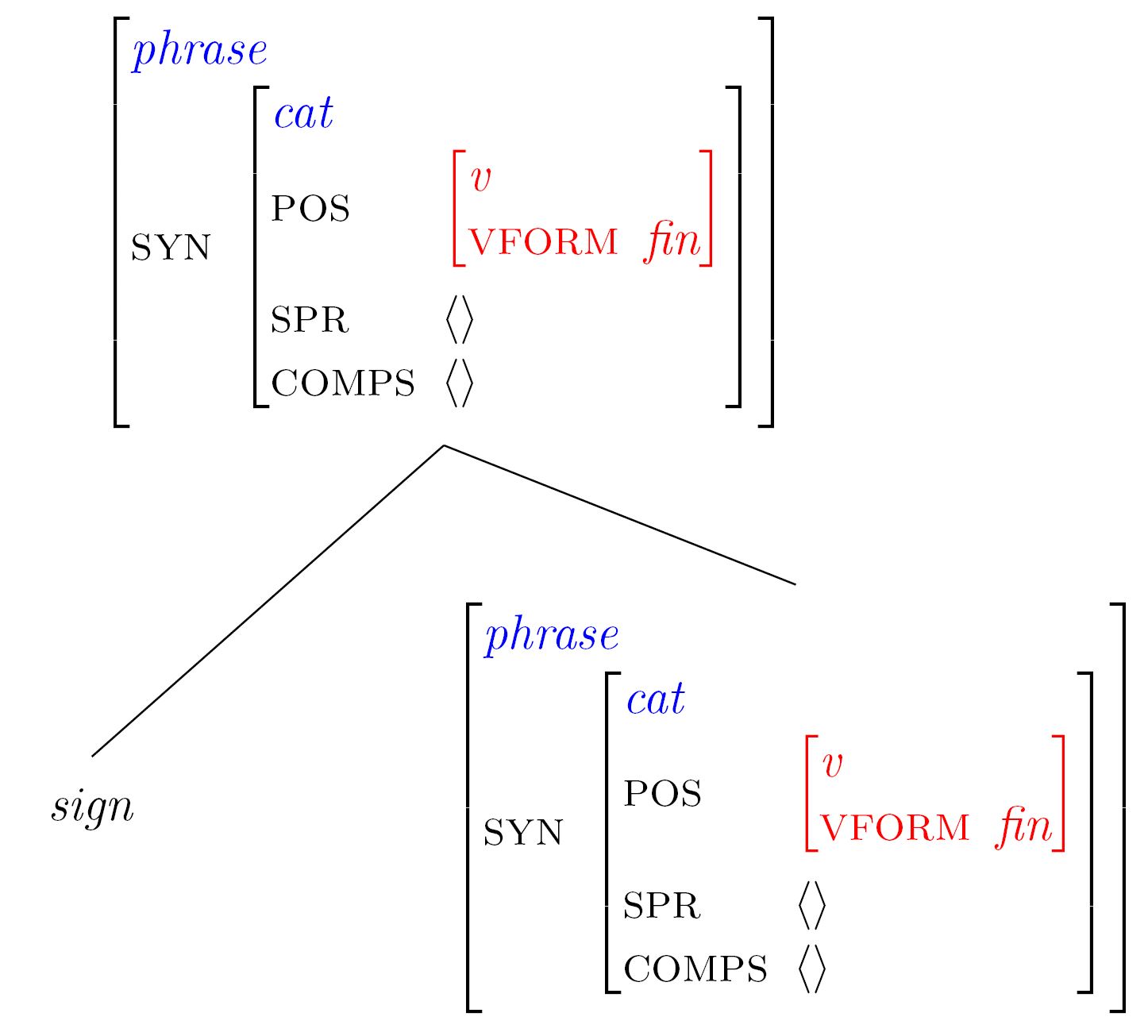Syntax 1 Wiki: Week 7
Probes and Topicalization
The probe
I have added a probe to the online grammar. According to the Cambridge Dictionary to probe means to examine something with a tool, especially in order to find something that is hidden.
Our probe is a word that (apart from the properties that every word must have according to the type hierarchy) has only only distinguishing piece of information: its PHON (= phonology) attribute carries the value <probe>, i.e. that is its pronunciation.
- Go to the online grammar.
- Find the entry probe in the lexicon and click on it.
- In the upper righthand side of the screen, click the green button 2.
- Now click on the tree and inspect it.
- Leave the grammar window open! We are going back to it a number of times.
As promised, the only piece of information that the word contains is its phonology. In particular, no syntactic information is displayed at all, since the program only displays information which goes beyond what the type hierarchy requires anyway.
There is a second new lexical entry. It is called test_prep. Click on it and click on the element in its COMPS list.
(0) What does [COMPS <cat>] mean?
Check your answer
The members of all valence lists are linguistic objects of type cat. Therefore, the preposition test_prep adds no further information about its complement than what the general grammar requires anyway.
(0) Which signs can appear in the complement position of test_prep?
Check your answer
Every sign, since every sign has a SYN value of type cat.
Exercises
In this exercise, you are supposed to parse a number of strings. Then, before you click on the probe's node, you are supposed to predict what information is contained in the probe.
Parse the following strings:
1. test_prep probe (choose tree 1)
2. from probe
3. visiting probe
4. probe smokes (choose the tree with S at the top)
5. probe dog (choose tree 2)
We are going to look at the last case in some more detail, to learn something about the mechanisms underlying the grammar. All the following exercises are about the last example.
(1) What is the difference between the probe in the tree and the probe in isolation?
Check your answer
- In the tree, the probe contains phonological and syntactic information.
- The attributes POS, SPR, and COMPS have specific values that cannot come from the lexical entry of the probe, which only contains phonological information.
So, the probe is doing its work: it makes hidden information visible, namely the information in the first daughter of an NP node whose second daughter is the word dog.
- Explain where that additional information comes from.
- After you have made a first guess, open the other two nodes as well.
- Again, explain where the syntactic information in the probe comes from.
(2) Where does the syntactic information in the probe come from?
Check your answer
- The syntactic information in the probe is the result of unification in the interplay of the lexical entry dog with the Head-specifier schema.
Here are the details:
- When you parse the string probe dog, you ask the program to try to make this string into a phrase.
- Each choice in the upper righthand corner gives a solution that the grammar has found.
- Solution 2 involves making the string into an NP using the Head-specifier schema.
- Recall that this schema combines a head daughter with a non-head daughter that is compatible with the category that the head daughter wants in its specifier.
- Open a second window of the online grammar.
- Choose the word dog from the lexicon and click on the D-node in the specifier list.
- Compare the information in the D-node with the information in the SYN value of the probe in the original grammar window.
(3) What causes this identity of information?
Check your answer
The Head-specifier schema. It enforces 3 unifications:
1. The word dog is unified with the phrase's head daughter.
2. The probe (technically just a word) is unified with the phrase's non-head daughter.
3. The schema unifies the head daughter's SPR value with the SYN value of the non-head daugther with the two occurrences of the tag 1:
In this syntactic context, the probe therefore must unify its information (its PHON value) with the information in the SPR list of dog. That is why the probe has part of speech D and empty valence lists. Convince yourself of this one more time by looking at the SPR list of the word dog in isolation.
More probing
- Keep both grammar windows open.
- Go back to the first grammar window you opened.
- Parse the string liking probe.
- Repeat the procedure we went through with the string probe dog above and explain why the probe has the property it does.
Try out the following strings as well:
1. spoke to probe
2. spoke probe
3. gave probe to lilly (choose tree 1)
4. probe a letter to lilly (choose tree 1)
5. probe probe (look at trees 3 and 5)
Topicalization
English has a construction called topicalization or sometimes also preposing. Here is an example of it. I am using personal pronouns in this example on purpose, to overtly show the case of the two NPs:
(1) Her he likes.
- Go to the online grammar.
- Parse the sentence above.
- See what happens.
(4) Explain the result informally.
Check your answer
The grammar does not parse the string for two reasons:
1. The verb likes lacks its NP complement.
2. There is an extra NP "her" at the beginning of the sentence.
(5) Go through the 3 schemas (Head-specifier, Head-complement, and SAI) and show that none of them licenses the substring he likes in sentence (1).
Check your answer
1. The Head-specifier schema requires the head daughter to be COMPS-saturated, but likes has a non-empty COMPS value.
2. The Head-complement schema linearizes the head daughter before its complement. As a pronoun, he has an empty valence, in particular an empty COMPS valence. Therefore, he cannot serve as the head of the Head-complement schema.
3. The SAI schema requires an [AUX plus] verb as the head daughter. But likes is [AUX minus].
So, none of the 3 schemas of the grammar can make he likes into a phrase.
Let us now try our luck with the string her he.
(6) Go through the 3 schemas (Head-specifier, Head-complement, and SAI) and show that none of them licenses the substring her he in sentence (1).
Check your answer
1. The Head-specifier schema requires the head daughter to select a SPR, but he has an empty SPR value.
2. The Head-complement schema requires the head daughter to select a complement, but her has an empty COMPS value.
3. The SAI schema requires an [AUX plus] verb as the head daughter. But her is is a noun and the feature AUX is only defined for verbs.
So, none of the 3 schemas of the grammar can make her he into a phrase either.
That leaves only one final theoretical possibility. If there were a schema that could combine all three words similtaneously into a phrase, then we would be all set. There are 2 ternary schemas in our grammar.
(7) Go through the 2 ternary schemas (the ternary Head-complement schema and SAI) and show that none of them licenses the substring her he likes in sentence (1).
Check your answer
1. The ternary Head-complement schema requires the head daughter to select 2 complements, but her has an empty COMPS value.
3. The SAI schema requires an [AUX plus] verb as the head daughter. But her is is a noun and the feature AUX is only defined for verbs.
This exhausts all our structure building devices for making a phrase out of the three words her, he, and likes. This means that our grammar predicts sentence (1) to be ungrammatical. Unfortunately, that is a wrong prediction. So, we need to make changes to our grammar if we want it to cover (1).
3 steps towards a solution for sentence (1)
We will now develop techniques for licensing strings like "her he likes" as sentences. We begin with the problem that our grammar does not allow "likes" to be a phrase.
Step 1 Licensing empty-looking positions: from the probe to the gap
There is a simple, if somewhat dubious, way to license likes as a phrase. Recall our probe:
The only real information it contains is its PHON value. But, theoretically, whereever you can have a non-empty list, you can also have an empty list. If we replace <probe> by < > in the word above, we get
The representaton above means the following:
- The gap is phonologically silent.
- Since the gap is syntactically completely unspecified, it can stand in for any sign whatsoever. The reason is simple: the gap's CAT value can unify with any other CAT value. In this respect, the gap is like a joker in a card game.
- The syntactic category of the gap also appears as the sole element on its gap list.
Exercise
- Go to the Online Grammar 2 with the gap above.
- Parse the following strings:
- Lilly likes (choose solution 6)
- Lilly spoke to (choose solution 3)
- Lilly spoke (choose solution 4)
Step 2 Licensing the extra expression at the beginning of the sentence
Exercise
- Go to the Online Grammar 2 with the gap above.
- Parse the following strings:
- him Lilly likes (choose solution 1)
- him Lilly spoke to (choose solution 3)
- to him Lilly spoke (choose solution 4)
- Parse the following strings:
- he Lilly likes (choose solution 1)
- he Lilly spoke to (choose solution 1)
- Lilly gave the apple to him
- to him Lilly gave the apple (choose solution 4)
- Lilly gave the apple at him
- at him Lilly gave the apple (choose solution 4)
Exercise:
- Parse all the sentences below and see whether you find a pattern in the data:
(1)
a. Lilly likes Fido.
b. Fido, Lilly likes __.
(2)
a. Lilly depends on Fido.
b. Fido, Lilly depends on __.
(3)
a. Lilly depends on Fido.
b. On Fido, Lilly depends __.
(4)
a. Lilly is fond of Fido.
b. Fido, Lilly is fond of __.
(5)
a. Lilly showed me a picture of Fido.
b. Fido, Lilly showed me a picture of __.
(6)
a. Lilly said I like Fido.
b. Fido, Lilly said I like __.
(7)
a. Lilly said I claimed she likes Fido.
b. Fido, Lilly said I claimed she likes __.
Because preposing can in principle span arbitrarily many clauses, it is one example of a long distance dependency!
(8) * Fido, Lilly smokes __.
(9) * To Fido, Lilly likes __.
(10) * She, Lilly likes __.
(11) * To Fido, Lilly depends __.
(12) * Fido, Lilly claims __ am sad.
(1) What pattern do (1)-(12) show?
Check your answer
An expression can be preposed from a position P if and only if it can occur in position P.
We distinguish between two kinds of phrases:
1. Stand(ard) phrases: hd-comp-ph, hd-spr-ph, hd-c-ph, sai-ph
2. Head-Filler phrases: top-ph, question
Remarks:
1. ⊕ is the list merger operator. (to merge = verschmelzen)
2. L1 ⊕ L2 is the new list L3 which contains all the elements of list L1 followed by all the elements of list L2.
Examples:
1. <> ⊕ < a > = < a >
2. < a > ⊕ <> = < a >
3. < a, a > ⊕ < a, b, c > = < a, a, a, b, c >
Navigation:



